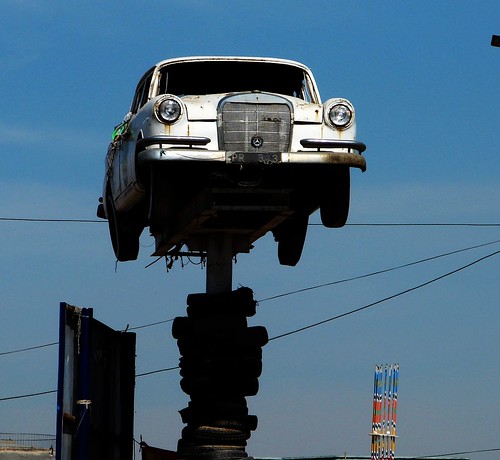
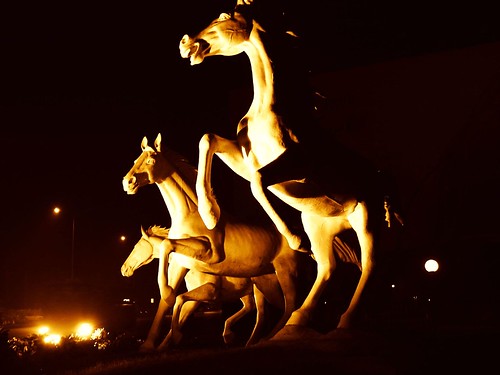

Rawalpindi - The Other Twin
Roadside decorations in Rawalpindi: Left-Hoisted Mercedes near safari Villa, Right: Three horses in front of Military Hospital (Photos courtesy: Jalalspages )
The twin cities of Rawalpindi and Islamabad are located at the backdrop of the Margalla Hills Rawalpindi on the Grand Trunk Road, some 270 kilometres from Lahore and 177 kilometres from Peshawar on the Pothohar Plateau. The history of Rawalpindi is unknown, but the excavations from the nearby Taxila date the area back to some 3000 years. The recorded history of Rawalpindi commences from the invasion of Mahmud of Ghazni from 979 A.D. onwards, when the small town was gifted to a Gakkhar Chief, Kai Gohar. However, it was given the name of Rawalpindi by a Gakkhar chieftain Jhanda Khan, after the village Rawal in 1493 AD. Rawalpindi remained with the Ghakkars, till they were defeated by the onslaught of the Sikhs in 1765 AD. With the arrival of the British in the Indian subcontinent, and their northward expansion, Sikhs lost Punjab including Rawalpindi to the British in 1849 AD.
Owing to the British expeditions to further north and on to Afghanistan, Rawalpindi soon became a military cantonment in 1851 and the British Army established their General Headquarters in south of the city. Thereafter, it continues to remain a rather military cantonment since even after the partition of British India, Pakistan retained its General Headquarters of the Pakistan Army in the same buildings. When Lord Dalhousie made Rawalpindi his headquarters of the then Northern Command, a need was felt to connect it with the rail link, hence Rawalpindi was connected with Lahore with rail link on 1 January 1886.
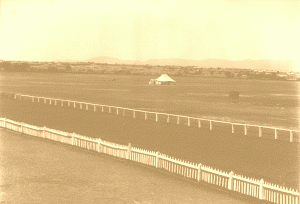
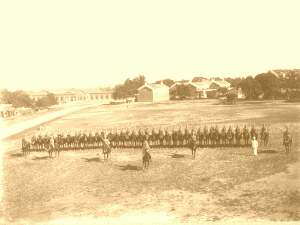
The British Days (From Left to Right) - Race Course Ground with West Ridge in the backdrop - Infantry Fall-in in front of Artillery Barracks
Upon creation of Pakistan, Rawalpindi remained the GHQ of Pakistan and continues to remain so. In 1951, Rawalpindi was witness to the murder of first Prime Minister of Pakistan, Mr. Liaquat Ali Khan, who was murdered by one Said Akbar on 16 October minutes after the Prime Minister rose to address a public gathering at what is now called Liaquat Bagh.
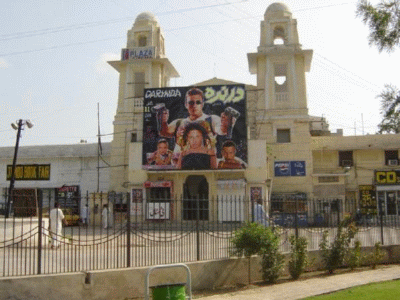 Rawalpindi has two distant
portions; the cantonment and the old city. The cantonment reminds the
British due to old barracks, which are now fast dwindling and new building
taking their place, the churches and cemeteries, Rawalpindi Club, now
renamed as Artillery Officers' Mess with an adjacent small cricket ground.
The Mall is the main artery of the Grand trunk Road which connects Lahore
with Peshawar, running through the cantonment area. The colonial-style
Flashman Hotel still survives on the main Mall, which has the offices of
Pakistan Tourism Development Corporation (PTDC) and is a haven for the
tourists looking for rather less expensive stay. On the Mall are two British
era cinema halls (left), now in repair wanting state, but the shows still go
on. Running parallel to the Mall, is the main shopping centre of the
cantonment, typically called the Sadder as in any cantonment of Pakistan and
India. Sadder is a thriving business and trade centre of Rawalpindi with a
number of hotels, banks, airlines and travel agents, beside being a busy
shopping centre. For tourists, handicraft shops on the Mall and Kashmir Road
are often the first choice.
Rawalpindi has two distant
portions; the cantonment and the old city. The cantonment reminds the
British due to old barracks, which are now fast dwindling and new building
taking their place, the churches and cemeteries, Rawalpindi Club, now
renamed as Artillery Officers' Mess with an adjacent small cricket ground.
The Mall is the main artery of the Grand trunk Road which connects Lahore
with Peshawar, running through the cantonment area. The colonial-style
Flashman Hotel still survives on the main Mall, which has the offices of
Pakistan Tourism Development Corporation (PTDC) and is a haven for the
tourists looking for rather less expensive stay. On the Mall are two British
era cinema halls (left), now in repair wanting state, but the shows still go
on. Running parallel to the Mall, is the main shopping centre of the
cantonment, typically called the Sadder as in any cantonment of Pakistan and
India. Sadder is a thriving business and trade centre of Rawalpindi with a
number of hotels, banks, airlines and travel agents, beside being a busy
shopping centre. For tourists, handicraft shops on the Mall and Kashmir Road
are often the first choice.
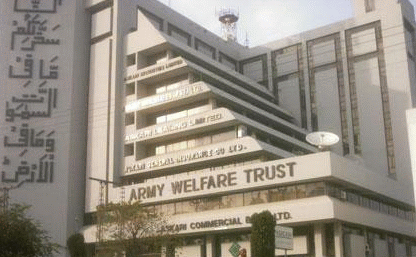
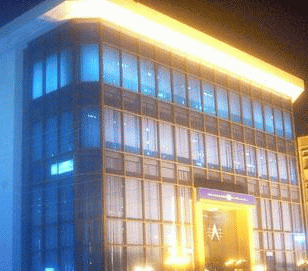
The thriving Rawalpindi skyline - photographs courtesy WorldIsRound
Harley Street west of the main Mall was once the modern locality of Rawalpindi. However, later other localities like Westridge, Chaklala and recently the Army Housing Schemes and the Bahria Town have provided planned and modern living to the city dwellers. In fact the area just after Rawat, on Lahore - Rawalpindi highway is being developed into new localities with favourable living and much needed amenities. The roads have also been widened to absorb the additional rush of traffic.

From the General Headquarters, to Murree, the road is Murree Road - the road leading to the other part of Rawalpindi. Crossing just under the railway bridge at the end of the cantonment limits, the first important place is the Liaquat Bagh - a garden named after the slain prime minister of Pakistan Liaquat Ali Khan, who was shot to death soon after he rose to address public gathering here in 1951. Thereafter, if one turn left, this is the old Rawalpindi leading to the "Bara Market" - the busiest market of old city stuffed with foreign good, electronics, and much more. Further right is the old "Raja Bazaar" - the whole sale market of everything. With narrow allies, one really has to wait for the traffic jams to clear and avoid as best you can, but someone will bump into you every now and then. The vendors encroach the road side selling vegetable, cheap electronic good, cloth etc. One can get away with very reduced prices if one knows the art of negotiating.
Murree Road, which was once very congested and had succumbed to the encroachments, has now been widened after removal of the encroachments and an underpass has also been constructed to allow smooth flow of traffic. However much more needs to be done to avoid congestion on this road. Rawal Road - a new link from Murree Road to airport has been added to provide easy access to dwellers of Satellite Town to airport, which otherwise had to travel long distance to reach the airport.
Rawalpindi is a modest city with nothing much of historical value, except the old buildings and the churches of the British days. In 60s, Ayub National Park was constructed over vast area to provide a planned park facility to the people of Rawalpindi. The park is located near the Attock Oil Refinery, spread over an area of about 2, 300 acres. The park has a play-land, lake with boating facility, an aquarium and a garden-restaurant. Next to the park is situated the Rawalpindi Golf Course, which was constructed as far back as 1926 by Rawalpindi Golf Club, which is one of the oldest gold clubs of Pakistan, founded on 2nd November 1885. The facility was initially developed as a nine-hole course, which has now been converted into a 27 hole course.
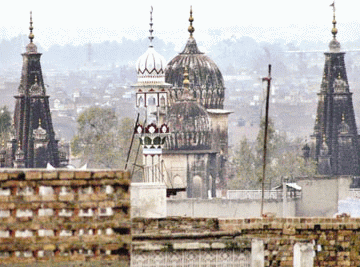
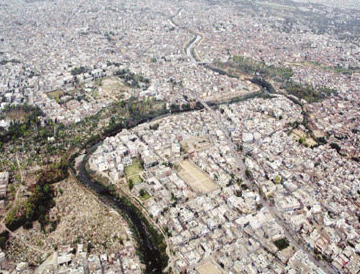
Left to Right - Haveli Sajhansingh (located in old city)- Panoramic View of Rawalpindi
Recently, the old Army Museum at the back of the Pearl Continental Hotel has been shifted to its new building. The museum has a fine collection of weapons, uniforms and paintings depicting Pakistan's military history. It remains open from 9 am to 3 pm in winters and 8 am to noon and 5.30 pm to 7 pm in summers.
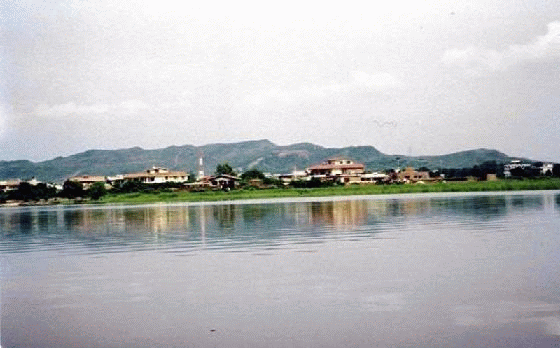
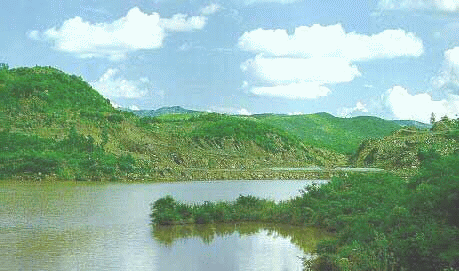
The Rawal and Simly Dams Lakes
Places around Rawalpindi include remains of Buddhism at Taxila, a half an hour drive from Rawalpindi on the Grand Truck Road, Khanpur Dam with its beautiful blue water lake is yet another half an hour drive from Taxila, situated 8 miles north of Taxila on the Haripur Road. It is a multipurpose project which supplies drinking water to Islamabad and Rawalpindi and irrigation water to NWFP (110 cusecs) and Punjab (87 cusecs). Beside provision of drinking water, it is an ideal place for day trip/picnic, boating, angling and watching migratory birds during winter. On Rawalpindi Murree Road are located two dams; Rawal Dam and the Simly Dam.
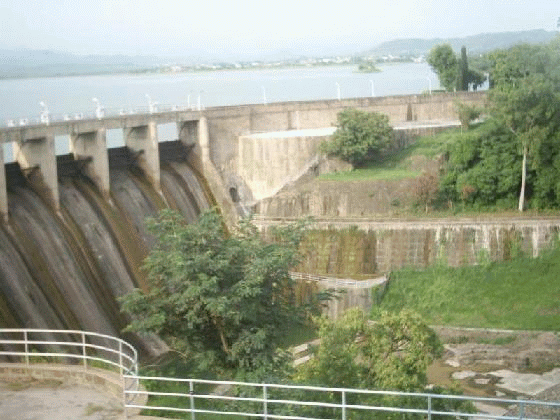
Rawal Dam - The Twin Cities' Lifeline
Rawal Dam: In view of the requirement of drinking water of Rawalpindi, Rawal Dam was built across the Korang Nallah, 9 miles from Rawalpindi, between 1960 and 1962. It is a concrete dam 700 feet long, 100 feet above the river bed. It has a storage capacity of 47,500 acre feet and covers 3.5 square miles. Along the right side is an outlet for 112 cusecs of water supply, 32 cusecs (16.5 million gallons per day) for urban water supply and the rest for irrigation.
Simly Dam: The dam, situated about 30km near the town of Bhara Kahu on main Rawalpindi-Murree road, was built in 1983, with its lake spread over an area of 28,750 acre. Besides providing drinking water to the twin cities, the dam also provides rest and recreation like boating, sailing and water skiing.
Some 40 kilometres from Rawalpindi on the Lehtrar Road are the remains of Pharwala Fort which was built by the Gakkhar ruler Kai Gohar in the 15th century on the ruins of a 10th century Hindi Shahi Fort. Emperor Babar conquered the fort in 1519 AD. Later, in 1825, Ghakkars were expelled by Sikhs from this fort. Though the fort is in a crumbling state, it is still an attraction for castle lovers. The fort being situated in a prohibited area and thus is only open for Pakistani visitors.
Rawalpindi also assumes importance for the reason that it is from here that all roads lead to the snow clad mountains of Pakistan. Nearest being Murree, atop 7,500 feet and one and a half hours drive from Rawalpindi. From Murree, one can go to Nathiagalli, Ayubia, Patriata which provide chair lift facilities and cool and pollution free environment amidst lush green mountains in summers and snow clad peaks in winters. From Rawalpindi, one can approach Kaghan/Naran through Abbotabad-Mansehra-Balakot and Swat / Malam Jabba through Nowshera-Mardan road.
Related Links: | Military Accounts Office Building |
|
| HOME PAGE | MORE CITIES | Copyright©JalalsPages - 2005 - 2009 |